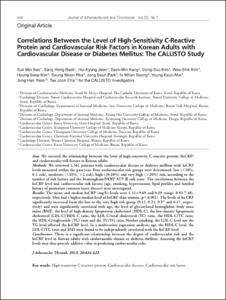KUMEL Repository
1. Journal Papers (연구논문)
1. School of Medicine (의과대학)
Dept. of Internal Medicine (내과학)
Correlations Between the Level of High-Sensitivity C-Reactive Protein and Cardiovascular Risk Factors in Korean Adults with Cardiovascular Disease or Diabetes Mellitus: The CALLISTO Study
- Keimyung Author(s)
- Kim, Hyung Seop
- Department
- Dept. of Internal Medicine (내과학)
- Journal Title
- Journal of Atherosclerosis and Thrombosis
- Issued Date
- 2013
- Volume
- 20
- Issue
- 7
- Abstract
- Aim: We assessed the relationship between the level of high-sensitivity C-reactive protein (hsCRP) and cardiovascular risk factors in Korean adults.
Methods: We reviewed 1,561 patients with cardiovascular disease or diabetes mellitus with hsCRP levels measured within the past year. Four cardiovascular risk groups were determined: low (<10%, 0-1 risk), moderate (<10%, >2 risk), high (10-20%) and very high (>20%) risk, according to the number of risk factors and the Framingham/NCEP ATP III risk score. The correlations between the hsCRP level and cardiovascular risk factors (age, smoking, hypertension, lipid profiles and familial history of premature coronary heart disease) were investigated.
Results: The mean and median hsCRP (mg/L) levels were 1.32±9.69 and 0.29 (range: 0.01-7.48), respectively. Men had a higher median level of hsCRP than women (p<0.001). The levels of hs CRP significantly increased from the low to the very high risk group (0.15, 0.23, 0.27 and 0.47, respectively) and were significantly correlated with age, the level of glycosylated hemoglobin, body mass index (BMI), the level of high-density lipoprotein cholesterol (HDL-C), the low-density lipoprotein cholesterol (LDL-C)/HDL-C ratio, the LDL-C/total cholesterol (TC) ratio, the HDL-C/TC ratio, the HDL-C/triglyceride (TG) ratio and the TC/TG ratio. Neither smoking, the LDL-C level nor the TG level affected the hsCRP level. In a multivariate regression analysis, age, the HDL-C level, the LDL-C/TC ratio and BMI were found to be independently correlated with the hsCRP level.
Conclusions: There is a significant relationship between the degree of cardiovascular risk and the hsCRP level in Korean adults with cardiovascular disease or diabetes mellitus. Assessing the hsCRP levels may thus provide additive value in predicting cardiovascular risks.
- Keimyung Author(s)(Kor)
- 김형섭
- Publisher
- School of Medicine
- Citation
- Suk Min Seo et al. (2013). Correlations Between the Level of High-Sensitivity C-Reactive Protein and Cardiovascular Risk Factors in Korean Adults with Cardiovascular Disease or Diabetes Mellitus: The CALLISTO Study. Journal of Atherosclerosis and Thrombosis, 20(7), 616–622. doi: 10.5551/jat.16089
- Type
- Article
- ISSN
- 1340-3478
- Appears in Collections:
- 1. School of Medicine (의과대학) > Dept. of Internal Medicine (내과학)
- 파일 목록
-
-
Download
 oak-aaa-2706.pdf
기타 데이터 / 929.01 kB / Adobe PDF
oak-aaa-2706.pdf
기타 데이터 / 929.01 kB / Adobe PDF
-
Items in Repository are protected by copyright, with all rights reserved, unless otherwise indicated.